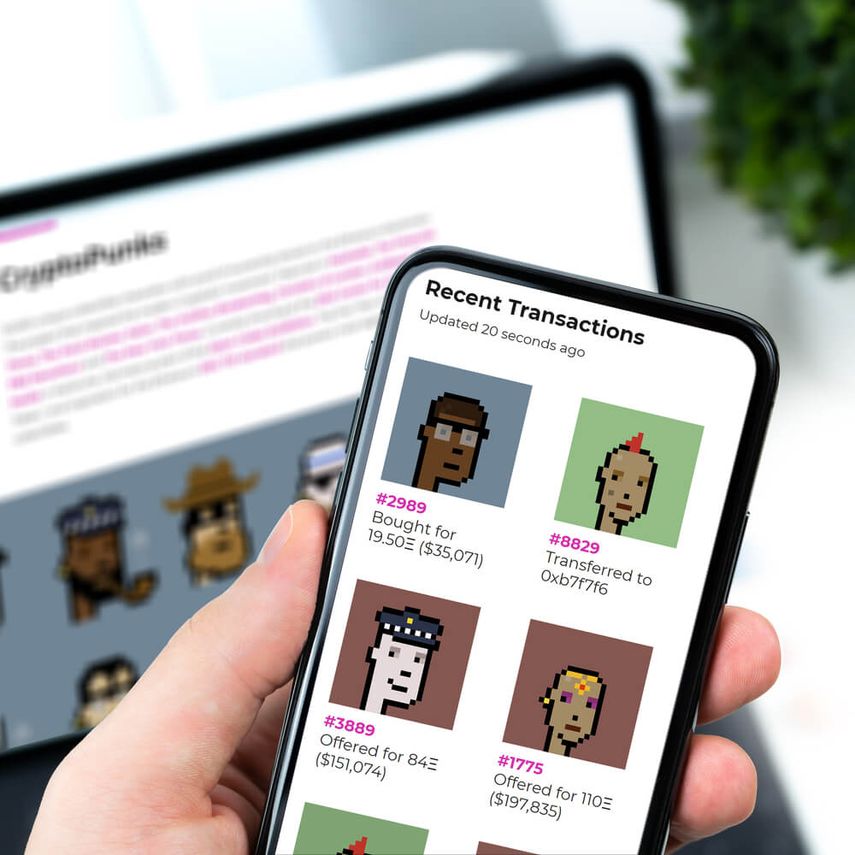Non-Fungible Token (NFT)
Non-fungible tokens (NFTs) are cryptographic assets on a blockchain with unique identification codes and metadata that distinguish them from each other. Unlike cryptocurrencies, they cannot be traded or exchanged at equivalency. This differs from fungible tokens like cryptocurrencies, which are identical to each other and, therefore, can serve as a medium for commercial transactions.
WHAT YOU NEED TO KNOW
- NFTs are unique cryptographic tokens that exist on a blockchain and cannot be replicated.
- NFTs can represent real-world items like artwork and real estate.
- "Tokenizing" these real-world tangible assets makes buying, selling, and trading them more efficient while reducing the probability of fraud.
- NFTs can also function to represent individuals' identities, property rights, and more.
The distinct construction of each NFT has the potential for several use cases. For example, they are an ideal vehicle to digitally represent physical assets like real estate and artwork. Because they are based on blockchains, NFTs can also work to remove intermediaries and connect artists with audiences or for identity management. NFTs can remove intermediaries, simplify transactions, and create new markets.
In early March 2021, a group of NFTs by digital artist Beeple sold for over $69 million. The sale set a precedent and a record for the most expensive pieces of digital art sold thus far. The artwork was a collage comprised of Beeple's first 5,000 days of work.
Much of the current market for NFTs is centered around collectibles, such as digital artwork, sports cards, and rarities. Perhaps the most hyped space is NBA Top Shot, a place to collect non-fungible tokenized NBA moments in digital card form. Some of these cards have sold for millions of dollars. Recently, Twitter's (TWTR) Jack Dorsey tweeted a link to a tokenized version of the first tweet ever, in which he wrote: "just setting up my twttr." The NFT version of the first-ever tweet sold for more than $2.9 million.
just setting up my twttr
— jack⚡️ (@jack) March 21, 2006
Understanding NFTs
Like physical money, cryptocurrencies are fungible, meaning that they can be traded or exchanged, one for another. For example, one bitcoin is always equal in value to another bitcoin. Similarly, a single unit of ether is always equal to another unit. This fungibility characteristic makes cryptocurrencies suitable as a secure medium of transaction in the digital economy.
NFTs shift the crypto paradigm by making each token unique and irreplaceable, thereby making it impossible for one non-fungible token to be equal to another. They are digital representations of assets and have been likened to digital passports because each token contains a unique, non-transferable identity to distinguish it from other tokens. They are also extensible, meaning you can combine one NFT with another to “breed” a third, unique NFT.
Just like Bitcoin, NFTs also contain ownership details for easy identification and transfer between token holders. Owners can also add metadata or attributes pertaining to the asset in NFTs. For example, tokens representing coffee beans can be classified as fair trade. Or, artists can sign their digital artwork with their own signature in the metadata.
NFTs evolved from the ERC-721 standard. Developed by some of the same people responsible for the ERC-20 smart contract, ERC-721 defines the minimum interface—ownership details, security, and metadata—required for the exchange and distribution of gaming tokens. The ERC-1155 standard takes the concept further by reducing the transaction and storage costs required for NFTs and batching multiple types of non-fungible tokens into a single contract.
Perhaps the most famous use case for NFTs is that of cryptokitties. Launched in November 2017, cryptokitties are digital representations of cats with unique identifications on Ethereum’s blockchain. Each kitty is unique and has a price in ether. They reproduce among themselves and produce new offspring, which have different attributes and valuations compared to their parents.
Within a few short weeks of their launch, cryptokitties racked up a fan base that spent $20 million worth of ether to purchase, feed, and nurture them. Some enthusiasts even spent upward of $100,000 on the effort. More recently, the Bored Ape Yacht Club has garnered controversial attention for its high prices, celebrity following, and high-profile thefts of some of its 10,000 NFTs.
Though the cryptokitties and Bored Ape Yacht Club use cases may sound trivial, others have more serious business implications. For example, NFTs have been used in private equity transactions as well as real estate deals. One of the implications of enabling multiple types of tokens in a contract is the ability to provide escrow for different types of NFTs—from artwork to real estate—into a single financial transaction.
Why Are Non-Fungible Tokens Important?
Non-fungible tokens are an evolution of the relatively simple concept of cryptocurrencies. Modern finance systems consist of sophisticated trading and loan systems for different asset types, ranging from real estate to lending contracts to artwork. By enabling digital representations of physical assets, NFTs are a step forward in the reinvention of this infrastructure.
To be sure, the idea of digital representations of physical assets is not novel nor is the use of unique identification. However, when these concepts are combined with the benefits of a tamper-resistant blockchain of smart contracts, they become a potent force for change.
Perhaps, the most obvious benefit of NFTs is market efficiency. The conversion of a physical asset into a digital one streamlines processes and removes intermediaries. NFTs representing digital or physical artwork on a blockchain remove the need for agents and allow artists to connect directly with their audiences. They can also improve business processes. For example, an NFT for a wine bottle will make it easier for different actors in a supply chain to interact with it and help track its provenance, production, and sale through the entire process. Consulting firm Ernst & Young has already developed such a solution for one of its clients.
Non-fungible tokens are also excellent for identity management. Consider the case of physical passports that need to be produced at every entry and exit point. By converting individual passports into NFTs, each with its own unique identifying characteristics, it is possible to streamline the entry and exit processes for jurisdictions. Expanding this use case, NFTs can serve an identity management purpose within the digital realm as well.
NFTs can also democratize investing by fractionalizing physical assets like real estate. It is much easier to divide a digital real estate asset among multiple owners than a physical one. That tokenization ethic need not be constrained to real estate; it can extend to other assets, such as artwork. Thus, a painting need not always have a single owner. Its digital equivalent can have multiple owners, each responsible for a fraction of the painting. Such arrangements could increase its worth and revenues.
The most exciting possibility for NFTs lies in the creation of new markets and forms of investment. Consider a piece of real estate parceled out into multiple divisions, each of which contains different characteristics and property types. One of the divisions might be next to a beach while another is in an entertainment complex, and yet another is a residential district. Depending on its characteristics, each piece of land is unique, priced differently, and represented with an NFT. Real estate trading, a complex and bureaucratic affair, can be simplified by incorporating relevant metadata into each unique NFT.
Decentraland, a virtual reality platform on Ethereum’s blockchain, has already implemented such a concept. As NFTs become more sophisticated and integrate into the financial infrastructure, it may become possible to implement the same concept of tokenized pieces of land (differing in value and location) in the physical world.
Frequently Asked Questions (FAQs)
What Are Some Examples of Non-Fungible Tokens?
Non-fungible tokens can digitally represent any asset, including online-only assets like digital artwork and real assets such as real estate. Other examples of the assets that NFTs can represent include in-game items like avatars, digital and non-digital collectibles, domain names, and event tickets.
How Can I Buy NFTs?
Many NFTs can only be purchased with Ether, so owning some of this cryptocurrency—and storing it in a digital wallet—is usually the first step. You can then purchase NFTs via any of the online NFT marketplaces, including OpenSea, Rarible, and SuperRare.
Are Non-Fungible Tokens Safe?
Non-fungible tokens, which use blockchain technology just like cryptocurrency, are generally secure. The distributed nature of blockchains makes NFTs difficult (although not impossible) to hack. One security risk for NFTs is that you could lose access to your non-fungible token if the platform hosting the NFT goes out of business.



